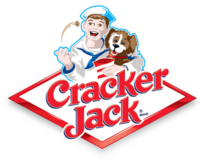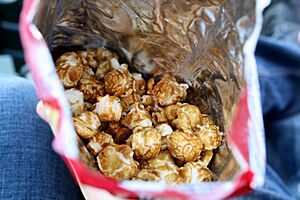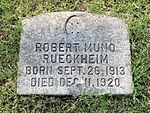Cracker Jack facts for kids
 |
|
 |
|
| Type | Caramel coated popcorn and peanuts |
|---|---|
| Owner | PepsiCo (via Frito-Lay) |
| Introduced | 1896 |
| Previous owners | The Cracker Jack Company Borden |
Cracker Jack is a super famous American snack! It's a yummy mix of popcorn and peanuts covered in sweet caramel. For a long time, every box came with a fun little prize inside.
The name "Cracker Jack" and its slogan, "The More You Eat, The More You Want," were officially registered in 1896. Many people connect Cracker Jack with baseball games. Since 1997, the snack has been owned by Frito-Lay. In 2016, Frito-Lay changed the prizes from small toys to QR codes. These codes let you download baseball-themed games on your phone.
Contents
How Cracker Jack Started
People have been making sugar-coated popcorn with peanuts for a long time. Records show it was sold in North America as early as the 1800s.
In Chicago, there are two main stories about how Cracker Jack began. One story says it was created by Charles F. Gunther, known as "The Candy Man." The other story gives credit to Frederick William Rueckheim, who was called "Fritz." Fritz started selling popcorn in Chicago in 1871.
A Sweet Idea at the World's Fair
Fritz and his brother Louis, who joined his business, came up with a new recipe. It included popcorn, peanuts, and molasses. They first showed this new snack at the World's Columbian Exposition in Chicago in 1893. This was a huge World's Fair!
However, this early version was very sticky. It was hard to eat because all the pieces stuck together.
The Secret to Separating the Snack
In 1896, Louis Rueckheim found a clever way to fix the sticky problem. He discovered that adding a small amount of oil during mixing helped separate the caramel-coated popcorn kernels. This oil was a secret ingredient! After this change, the snack was much easier to handle and enjoy.
Naming and Packaging Cracker Jack
The first official batch of Cracker Jack was made in 1896. That's also when the name and the slogan "The More You Eat, the More You Want" became official. The name "Cracker Jack" came from a saying. If something was "crackerjack," it meant it was excellent or top-notch!
In 1899, Henry Gottlieb Eckstein created a special "waxed sealed package." This package kept the snack fresh and protected it from dust, germs, and moisture. It was called the "Eckstein Triple Proof Package."
In 1902, the company changed its name to Rueckheim Bros. & Eckstein. A few years later, in 1907, a famous song came out called "Take Me Out to the Ball Game." This song helped make Cracker Jack even more popular because it mentioned the snack with the line: "Buy me some peanuts and Cracker Jack!"
In 1922, the company's name changed again to The Cracker Jack Company.
Meet Sailor Jack and Bingo
Cracker Jack has two famous mascots: Sailor Jack and his dog, Bingo. These characters were drawn by Andrew Loomis and first appeared around 1916. They became an official trademark in 1919.
Sailor Jack was actually based on Frederick Rueckheim's grandson, Robert Rueckheim. Sadly, Robert passed away at age 7, not long after his image was used. The sailor boy image was so important to the founder that he had it carved on his own tombstone.
Who Owns Cracker Jack?
The Cracker Jack Company was bought by Borden in 1964. It was made in Northbrook, Illinois, for many years.
In 1997, Borden sold the brand to PepsiCo, which also owns Frito-Lay. Cracker Jack then became part of the Frito-Lay family of snacks. Frito-Lay moved the production of Cracker Jack to Wyandot Snacks in Marion, Ohio.
In 2013, Frito-Lay announced some changes to Cracker Jack. They added more peanuts and updated the prizes to be more modern and fun.
Cracker Jack'D Snacks
On April 30, 2013, Frito-Lay launched a new line of snacks called Cracker Jack'D. These snacks were different from the original Cracker Jack. They came in black packaging instead of the classic red and white. They also showed a close-up picture of Sailor Jack and Bingo.
Unlike the original Cracker Jack, the Cracker Jack'D snacks did not include prizes. One of the Cracker Jack'D products, called Power Bites, caused some discussion. This was because it contained caffeine, and some people worried about it being in food, especially for kids or pregnant women.
Cracker Jack and Baseball
Cracker Jack is super famous for being sold at baseball games. It's even mentioned in the classic American song "Take Me Out to the Ball Game"!
From 1982 to 1985, Cracker Jack sponsored special "Old-Timers Classic" baseball games. These games featured former MLB players and were held in Washington, D.C.
On June 16, 1993, Cracker Jack celebrated its 100th birthday at Wrigley Field during a game between the Cubs and the Florida Marlins. Before the game, Sailor Jack, the mascot, even threw out the first pitch!
In 2004, the New York Yankees baseball team tried to replace Cracker Jack with a different snack at their home games. But fans were upset! So, the team quickly brought Cracker Jack back.
Cracker Jack on TV
The Cracker Jack Company started advertising on television in 1955. They sponsored a TV show called On Your Account on CBS.
Actor Jack Gilford was in many Cracker Jack TV commercials from 1960 to 1972. He was known as the "rubber-faced guy on the Cracker Jack commercials" for 12 years!
Puppeteer Shari Lewis and her famous puppet Lamb Chop also appeared in Cracker Jack commercials in 1961.
A new TV ad for Cracker Jack aired during Super Bowl XXXIII on January 31, 1999. This was the first time Cracker Jack had been advertised on TV in 15 years! The ad showed off the company's new bag packaging, which was a big change from the classic box.
The Fun Prizes Inside
Cracker Jack boxes originally came with a small "mystery" novelty item called a "Toy Surprise." The old slogan for Cracker Jack was "Candy-coated popcorn, peanuts and a prize." Now, under Frito-Lay, it's "Caramel-coated popcorn & peanuts."
Prizes have been included in every box of Cracker Jack since 1912. One of the very first prizes, in 1914, was a set of Cracker Jack baseball cards! These cards featured players from major leagues. Early "toy surprises" included things like rings, plastic figures, small booklets, stickers, temporary tattoos, and even decoder rings. People love collecting these prizes, and there are even books written about them!
Before 1937, many Cracker Jack toy prizes were made in Japan. During World War II, the prizes were made of paper because metal was needed for the war effort.
In the 1961 movie Breakfast at Tiffany's, the main characters get a ring from a Cracker Jack box and have it engraved.
Over time, the toy prizes changed. Under Frito-Lay, the small toys were replaced with paper prizes that had riddles and jokes, and then temporary tattoos. In 2013, some prizes became codes that people could use to play "nostalgic" games on the Cracker Jack app. In 2016, it was announced that these game codes would completely replace the physical prizes.
See also
 In Spanish: Cracker Jack para niños
In Spanish: Cracker Jack para niños




